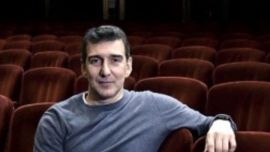If the so-called “corruption notebooks” scandal blew the lid off what was a public-private system of illicit gains generated during the Kirchnerite years, it was only thanks to the D’Alessio-Stornelli case that society was able to clearly see the ramifications of how Justice in Argentina is twisted and turned to reflect the whims of a select few. Both cases are intimately tied to the will of federal judge Claudio Bonadio, who had requested a leave of absence starting May 1 and which would last fifteen days, as he needed to take care of medical issues. What was a supposed secret hidden in plain sight in the Comodoro Py federal courthouse, that Bonadio suffered some dangerous ailment, exploded like a single lightning discharge on Friday, taking over social media as journalist Horacio Verbitsky revealed details of a brain tumor which could leave the infamous judge out of commission for the foreseeable future, maybe even the rest of his life.
Amid the ominous silence of outlets like Clarín, La Nación, and Infobae, information came and went regarding the severity of the cerebral lesion. The brain tumor revealed by Verbitsky, confirmed by “a prosecutor and a judge that is good friends with him,” was actually a cyst that caused complications with the optic nerve, another source claimed. Close to the judge, lips had been sealed tight since the early morning in his office, yet a message of relative optimism made its way out: judge Bonadio was checked on Thursday and will undergo surgery today at Fleni Institute, which specializes neurology. While they didn’t confirm the leisure, they noted he would be back to work by mid-May. Highlevel sources in Comodoro Py consulted by Perfil had initially confirmed it was a benign tumour, which would mean a biopsy had already been performed, yet that information was later changed to reflect the fact that the true nature of the lesion remained under seal. Infobae, historically close to Bonadio, finally put out a piece confirming the judge was undergoing treatment for stress and would be out until May 15, during which period he would be replaced by federal judge Ariel Lijo in the “K money route graft” case. It wasn’t immediately clear who would lead cuadernos.
As is the case with most things surrounding the Argentine judiciary, everything has to do with everything. Cases ex- t e n d f o r years as judges and pro- secutors come and go, with hundreds of thousands of pa- ges being written, evidence compiled, and very little coming to h a p p e n . The AMIA ter r o r i s t bombing c a s e r e - mains unresol - ved, for exam - ple, while it took 22 years for the coverup case to reach a final juncture, at which former President Carlos Menem was cleared to the surprise of many. Special Prosecutor Alberto Nisman appeared dead from a bullet wound to the head four years ago as he investigated the AMIA bombing, and we’re still waiting for police investigators to parse through telephone records. With both cuadernos and D’Alessio-Stornelli on the line, it would be a pity if something truly happens to Bonadio rendering him unfit to carry on, and, if need be, respond to accusations against him.
Just to be clear, former President Cristina Fernández de Kirchner has been indicted in eleven different cases of corruption, for which she’s had five preventive prison requests, and five trials in different stages of advancement. Ten of those cases are or have been in judge Bonadio’s hands. Cristina’s first trial is scheduled to begin on May 21, where she will sit on the bench alongside former federal planning minister Julio De Vido, public works secretary José López, and disgraced businessman Lázaro Báez, among others. They are accused of handing over public works projects to people like Báez in exchange for bribes. In a related case known as Hotesur, Cristina and her children—Máximo and Florencia—are accused of laundering that money through their hotels Alto Calafate, Las Dunas and La Aldea. Cristina has shielded her daughter by taking her to Cuba for a medical treatment that raises suspicion, while she and Máximo hold Congressional immunity. Bonadio continues to breathe down her neck in the cuadernos case, which has been soiled by federal prosecutor Carlos Stornelli. Working in tandem, Bonadio and Stornelli charged 100 businessmen and Cristina, extracting plea bargains that would prove collusion between corrupt businessmen and Kirchnerite officials to extort hundreds of millions from the state. Doubts remain as to whether the case was being turned toward Cristina, with businessmen being “pressured” into involving her. The evidence leaves a pretty clear trace of what her henchmen were doing, yet Stornelli’s involvement with a pseudo-spy involved with the AFI intelligence agency has cast a massive shadow over the whole investigation.
Stornelli relied on illicit espionage for information picked up by thugs like Marcelo D’Alessio, who collaborated with organic and inorganic AFI agents, and had access to information provided by foreign intelligence agencies, including those tied to the US Embassy. D’Alessio also extorted sketchy businessmen out of money in order to keep their freedom, supposedly helping them avoid prosecution in corruption cases. Stornelli was not alone in using this information, as judge Alejo Ramos Padilla of Dolores has been investigating, he was joined by the likes of Elisa “Lilita” Carrió and Prosecutor Juan Ignacio Bidone, who worked on the “General Rodríguez triple homicide” drug case, among others. The more judge Ramos Padilla investigates, the farther the network extends, to the point where it has also reached “bagman” Leonardo Fariña, the main witness in the “K money route” case. Whether Bonadio was a willing part of the espionage ring, or benefitted from it, remains to be seen. What is clear is that every high-profile corruption case is currently under suspicion and the impartiality of judges, prosecutors, witnesses and journalists is no longer taken for granted. Can justice occur in this context? What is justice?
It all seems to go full circle. Bonadio, the vindictive judge that has been on Cristina’s tail since 2015, is probably the only man that can set the precedents that could put an end to public-private corruption in Argentina. At the same time, he remains suspiciously close to illicit acts of extortion that could derail the whole investigation, despite what appears to be clear evidence of foul play.
In Argentina, sometimes, it’s very difficult to pick sides.






















Comments